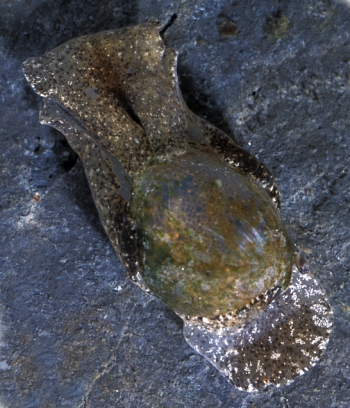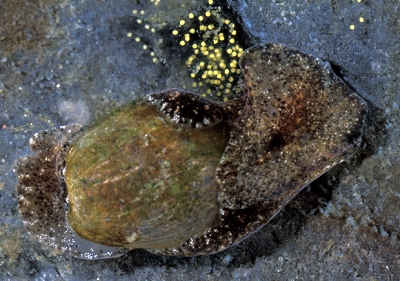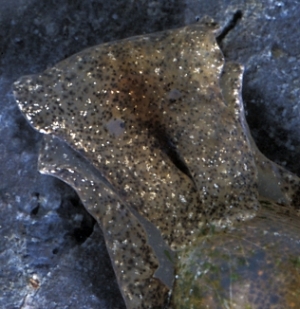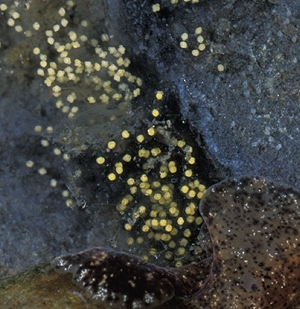
Haminoea japonica
(Pilsbry, 1895)
Order: CEPHALASPIDEA
Superfamily: HAMINOEOIDEA
Family: Haminoeidae
DISTRIBUTION
North Pacific both west and east coasts. Atlantic coast of Spain, Venice Lagoon (Mediterranean). If identification correct this species is apparently endemic to the northwestern Pacific, but has spread to the north American Pacific coast and the Atlantic coast of Spain and also to the Venice Lagoon.
PHOTO
Lake Merritt, California, USA. Photographer: Dave Behrens
As mentioned in Dave Behren's accompanying message [#17702] this species was described as a new species, Haminoea callidegenita Gibson & Chia, 1989 but is now being considered a junior synonym of the Japanese species, Haminoea japonica (also reported as Haloa japonica) [see Behrens & Hermosillo, 2005]. A full anatomical comparison of H. callidegenita and H. japonica from from both Japan and the eastern North Pacific is in preparation (Gosliner & Behrens, in prep).
One external character is the very pronounced cleft between the two posterior lobes of the head shield. As H. callidegenita this species has had a biological 'claim to fame' as a species with two development types, some specimens producing lecithotrophic - non-feeding planktotrophic - larvae, and others capsular metamorphic larvae, which undergo development, including a veliger stage, within the egg capsule, before hatching. As Haminoea japonica, this species was long placed in a genus Haloa, but there are no anatomical differences between it and Haminoea [see Rudman, 1971a, b).
-
Alvarez, L.A., Martínez E., Cigarría, J., Rolán, E. & Villani, G. (1993) Haminaea callidegenita Gibson & Chia, 1989 (Opisthobranchia: Cephalaspidea), a Pacific species introduced in European coasts. Iberus, 11(2): 59-65.
-
Behrens, D. W. and Hermosillo, A. (2005) Eastern Pacific Nudibranchs. A Guide to the Opisthobranchs from Alaska to Central America. Monterey, California, Sea Challengers. 1-137.
-
Gibson, G.D. & Chia F.S. (1989) Description of a new species of Haminoea, Haminoea callidegenita (Mollusca: Opisthobranchia), with a comparison with two other Haminoea species found in the northeast Pacific. Canadian Journal of Zoology, 67: 914-922.
-
Gibson, G.D., and Chia, F.-S. 1989b. Developmental variability (pelagic and benthic) in Haminoea callidegenita (Opisthobranchia:
Cephalaspidea) is influenced by egg mass jelly. Biol. Bull. (Woods Hole), 176: 103–110. -
Gibson, G. D. & Chia, F.S. (1995) Development variability in the poecilogonous opisthobranch Haminoea calledegenita: life history traits and effects of environmental parameters. Marine Ecology - Progress Series, 121(1-3): 139-155.
-
Marín A., Alvarez, L.A., Cimino, G. & Spinella, A. (1999) Chemical defense in Cephalaspidean Gastropods: origin, anatomical location and ecological roles. Journal of Molluscan Studies, 65: 121-131.
-
Rudman, W.B. (1971): On the opisthobranch genus Haminoea Turton & Kingston. Pacific Science, 25(4): 545-59, 12 figs.
-
Rudman, W.B. (1971) Structure and functioning of the gut in the bullomorpha (Opisthobranchia) Part 1. Herbivores. Journal of Natural History, 5(6): 647-675, 18 figs.
Rudman, W.B., 2006 (October 25) Haminoea japonica (Pilsbry, 1895). [In] Sea Slug Forum. Australian Museum, Sydney. Available from http://www.seaslugforum.net/find/hamijapo
Related messages
Haminoea callidegenita or H. japonica
October 26, 2006
From: Dave Behrens

Hi Bill:
Per your request [following message #17553], here is what I know about the Haminoea callidegenita situation here. Although not officially published yet in a refereed journal, a couple of web sites have reported Haminoea callidegenita Gibson & Chia, 1989a as a junior synonym of Haminoea japonica Pilsbry (also reported as Haloa japonica). This situation will be remedied soon with the publication of a full anatomical comparison of H. callidegenita and H. japonica (Gosliner & Behrens, in prep.). In this paper specimens from both Japan and the eastern Norht Pacific are examined.
Until that surfaces, here are photos of this species from Lake Merritt (a finger of), San Francisco Bay, California. You will notice, as Sandra's message [#7141] points out, externally H. japonica (= H. callidegenita) has a deeply bifurcate posterior edge to the headshield, seen in these photos. Internally the species are identical, and differ dramatically from H. virescens and H. vesicula.
I wish I had paid more attention to the eggs these specimens were laying, but I believe these are the direct development eggs described by Gibson & Chia. This species seems to be widely distributed as reported by Alvarez, Martinez, Cigarria, Rolan & Villani (1993).
-
Alvarez, L.A., Martínez ,E., Cigarria, J., Rolán, E. and Villani, G., (1993) Haminaea callidegenita Gibson & Chia, 1989 (Opisthobranchia: Cephalaspidea), a Pacific species introduced in European coasts. Iberus, 11(2): 59-65.
-
Gibson, G.D. and Chia, F.S. (1989). Description of a new species of Haminoea, Haminoea callidegenita (Mollusca: Opisthobranchia), with a comparison with two other Haminoea species found in the northeast Pacific. Canadian Journal of Zoology, 67: 914-922.
-
Gibson G. D. and Chia F.S., 1995. Development variability in the poecilogonous opisthobranch Haminoea calledegenita: life history traits and effects of environmental parameters. Marine Ecology - Progress Series, 121(1-3): 139-155.
-
Marín A., Alvarez L.A., Cimino G. and Spinella A., 1999. Chemical defense in Cephalaspidean Gastropods: origin, anatomical location and ecological roles. Journal of Molluscan Studies, 65: 121-131.
Dave Behrens
dwbehrens@comcast.net


Thanks Dave,
Bill Rudman
